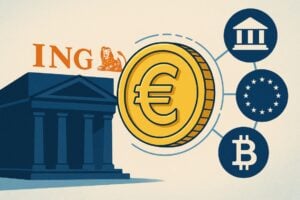The Dutch bank ING is reportedly working on the creation of its own euro-pegged stablecoin, in collaboration with other European banks and companies active in the cryptocurrency sector.
Although the project has not yet been formally approved by the bank’s top management, the initiative appears concrete and fits fully into the new European regulatory context.
A European consortium for euro stablecoins, beyond ING’s initiative
The project of the bank ING represents an important step forward in the integration between the traditional banking system and digital technologies.
According to reports, ING is said to be developing a stablecoin project that brings together major players from the financial world and the crypto sector.
The main objective is to take advantage of the new European regulation MiCA (Markets in Crypto-Assets Regulation), approved to regulate the cryptocurrency sector in the Union.
Thanks to the framework provided by MiCA, there are now precise rules for issuers of stablecoin linked to the euro, which must meet stringent requirements.
Among these, obtaining a specific license and maintaining adequate financial reserves held at European banks.
This regulatory framework seems to have created the fertile ground for the entry of large traditional banks into the landscape of criptovalute.
ING, in particular, presents itself as a potential protagonist in a game that has so far been dominated by alternative players or individual experiments, such as the one already carried out by Société Générale with its EURCV, managed by the subsidiary SG Forge.
One of the most interesting aspects of ING’s project is the organizational form through which it could come to light: a consortium. It would be a common platform managed together with other European banks and some major companies in the cryptocurrency sector.
A strategy that, although it may extend the development time due to the necessary internal approvals, would allow for greater robustness of the project.
In fact, each bank involved in the consortium must obtain the approval of its board of directors to proceed with the creation of a new legal entity that will act as the issuer of the stablecoin.
A long but necessary procedure, especially considering the regulatory implications and the need to act jointly in a sector still highly controlled.
The ambition, far from being contained, is to create a reliable digital tool and efficient that can promote the digitalization of the European economy, providing a credible alternative to the projects currently in circulation.
A direct challenge in the European crypto landscape
The ING project, if realized, could transform the balances in the emerging market of digital payments based on euro stablecoin.
The initiative would directly challenge projects already underway such as that of Société Générale, a pioneer in Europe in the creation of a regulated bank stablecoin.
Furthermore, the deployment of more banking players would help consolidate the image of the European financial sector as an active part in the digital innovation process, and not just as a mere spectator.
The strategy of ING, therefore, aims to transform the digital euro into a competitive tool, capable of facing the growing presence of cryptocurrencies and decentralized financial services.
However, the banks will have to act cautiously to avoid coming into conflict with the European Commission, which is working to create its own Central Bank Digital Currency (CBDC).
The digital euro project promoted by Brussels, in fact, represents a potential direct competitor to any stablecoin issued on the continent.
One of the reasons why this type of projects has gained traction only recently is related to the regulatory context. Before the approval of the MiCA regulation, the operations of stablecoin issuers were often subject to legal uncertainty.
Today, however, the rules have changed: European banks can enter the market in a compliant manner and with their own instruments, provided they adhere to strict criteria of transparency, reserve, and operational license.
While on one hand this regulation ensures greater protection for users and stability to the cryptocurrency ecosystem, on the other hand it increases the time and complexity to complete initiatives like that of ING.
However, those who manage to overcome these obstacles could gain a competitive advantage in the medium term.
The future of euro stablecoins
The growing interest from European banks towards euro stablecoins is a strong signal. The traditional banking sector has no intention of staying on the sidelines of technological change.
The choice of ING to ally with other banking institutions and crypto enterprises suggests a new model of collaboration between traditional finance and decentralized innovation.
The project of a euro stablecoin branded ING is still in the preliminary phase. However, it already fuels the debate on what will be the true face of the European digital currency.
Among the experiments launched privately by banks and those of a public nature promoted by community institutions, the only certainty is that the transformation of money into digital form has already begun.
It will now be necessary to see if ING will manage to obtain the necessary internal green light and shape its own stablecoin before the definitive arrival of the European MNBC. Which is destined to become the most relevant competitor in this growing ecosystem.







